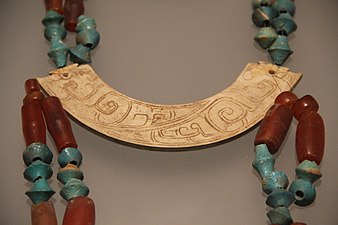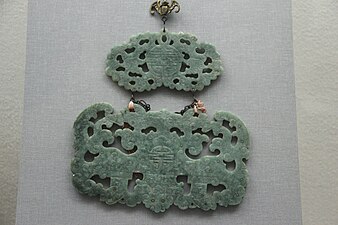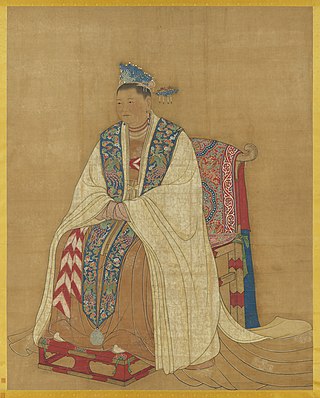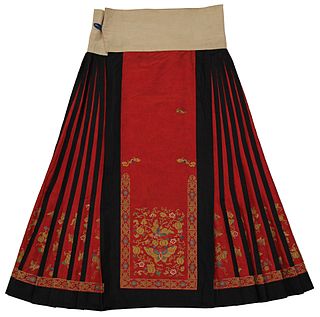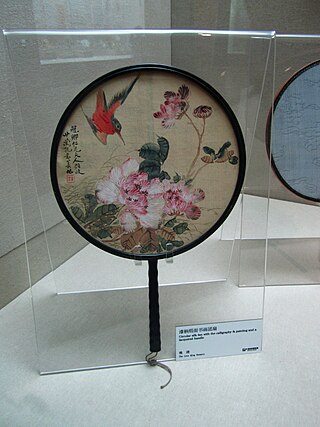Jewellery
Chinese jewellery, including Chinese carved jade jewellery, often features Chinese symbols and iconography, and auspicious symbols and images, which are themselves rooted in Chinese culture, legends and mythologies, and philosophy. [1] [2] : 213 These symbols often reveal the Chinese traditions which have guided the Chinese civilization for thousands of years and which currently continue to remain in use in present-days. [1]

Jade culture is an important aspect of Chinese culture, [3] reflecting both the material and spiritual culture of the Chinese people. [4] : 18 Jade is deeply ingrained in Chinese culture and played a role in every aspect of social life; [4] : 18 it is also associated with positive qualities and aspects such as purity, excellence, and harmony. [5] : 20 [6] : 94 Jade is even more valued than gold in Chinese culture. [6] : 94 Traditionally, jade jewellery especially often expressed positive sentiments and good wishes; and, jade itself were often gifted on important and/or special occasions such as wedding and child birth. [1]
Silver was another common materials in the making of Chinese ornaments and ritual items since ancient times; it also holds an irreplaceable place in Chinese culture and plays a significant role in being a carrier of Chinese traditional culture and in preserving ancient Chinese cultural heritage. [2] : 213 Moreover, according to Chinese belief, silver could be used to avoid evil spirits and thus wearing silver ornaments and jewelries was believed to bring good luck to its wearer. [2] : 213
Other materials used in traditional Chinese jewellery making were: gold, shanhu (lit.' coral '), zhenzhu (Chinese :真珠; lit.' pearl '), lüsongshi (lit.' turquoise '), chensha (lit.' cinnabar '), niugu (lit.' ox bone '). [7] : 250 Niugu was used as an alternative to a rare material known as xiangya (lit.' ivory '). [7] : 250 Zuanshi (lit.' diamond '), on the other hand, was typically not used in traditional Chinese jewellery as it considered too bright and vulgar; and thus, it was generally avoided. [7] : 250
Bracelets

Jade bracelets have been favoured by Chinese women since ancient times regardless of social ranking [8] and has been one of the most important form of jewellery in Chinese culture. [9] According to ancient Chinese beliefs, jade bracelets should be worn on the left hand as it is closest to the heart. [8] Chinese women typically had at least three jade bracelets throughout her lifetime: the first one was given by her father as a little girl, the second is given to the girl by her mother when she gets married and which will be passed from generation to generation as a family heirloom, and the third one (regardless of the price and the quality) is given to the girl by her lover to express his love and his desire to protect her for a lifetime, which led to the saying, "no bracelet can't get married". [8] Another jade bracelet may be given by a mother-in-law to her new daughter-in-law when she gets married. [8] There is a belief in China which says that if a jade bracelet breaks, the death of its wearer has been supplanted by the broken bracelet. [10] : 160 Jade bracelets continue to be prized and worn nowadays. It is also currently used as a form of fashion accessory used by hanfu enthusiasts. [11]
Earrings

Earrings in China originated in the Neolithic period; however, they were first used as decorations or amulets. [12] A form of popular earring which pierced the earlobe was the er dang (Chinese :耳珰) which became popular during the Warring States Period and the Qin dynasty. [13] Ancient er dang were made out gold, jade, silver, ivory, marble, glass and crystal. [13] Glass er dang became popular from the Han dynasty to the Southern and Northern dynasties due to its bright colours and due to its glittering characteristics and translucence. [13]
In the Zhou dynasty, when in the form of jade pendants, the earrings could also be used as decorations to be hanged on guan , a form of Chinese headgear; [12] they were especially used on the mianguan of the Emperor where they became known as chong er (lit.'ear plugs'). [14] When used on headgear, the chong er were a representation of self-discipline and introspection, both of which were important required characteristics in Chinese culture; the purpose of these jade pendants decorations thus reminded its wearer that he should avoid hearing and listening to anything without careful consideration and avoid slander while simultaneously remind the wearer that he should show humility and listen to good suggestions. [12] [14] These jade pendants gradually spread from the Emperor to officials and scholars, to women who would then hang it to their Chinese hairpins. [12] The er dang attached to hairpins were used by empresses, imperial concubines and princesses during the Han dynasty allowing the er dang to hung down beside their two ears. [13]
Based on archaeological findings, it appears that it was a popular trend for ancient women to only wear a single er dang (especially on the left ear) instead of pairs of earrings. [13] During the Song dynasty that women started to piece their two ears and wore er dang; these earrings could be made with gold and pearls. [12] Wearing earrings among Chinese women then became popular in the Ming and Qing dynasties. [12]
In the Ming dynasty, the practice of wearing a single earring on the ear was not customary for Chinese men, and such practices were typically associated with the non-Chinese people living along the northern and north-western borders; however, there is an exception: young Chinese boys would wear a single ring-shaped earring attached to their ear as an amulet to protect them against evil spirits. [15] : 208
In Qing dynasty, Han Chinese women wore a single earring at each ears which contrasted from the Manchu women who had to wear three earrings at each ear. [16] From the middle of the eighteenth century, Manchu women adopted the Han Chinese single earring despite breaking the Manchu dress code and the laws which prevented them from wearing Han Chinese women clothing; this frustrated the Qing emperors. [16] [17]
- A young Chinese boy wearing single ring-shaped earring on the left ear, Ming dynasty
- Song dynasty empress wearing single gold earring at each ear.
- Pearl pendant earring, Song dynasty
- Empress of Ming wearing a dangling earring at each ear.
Rings
Rings were initially used as decorations and finger protection when drawing bows since the Neolithic period. [12] They were then given to the Empresses and imperial concubines in the Emperor's concubines to express or indicate their current physical conditions by the Emperor; by the time of Qin and Han dynasties, a gold ring worn on the left hand were used to express being on menstruation or being pregnant and thus that its wearer were unsuitable to serve the Emperor while a silver ring on the left hand expressed that its wearer was available to serve the Emperor; following a night with the Emperor, the silver ring would be moved from left to the right hand. [12] This custom was then gradually spread to the nobles and officials before spreading to the civilians. [12]
Rings which were mostly made of precious materials, such as jade, gold, and silver, were also bestowed presents to accomplished court officials and they were used as love token by couples. [12] Rings later became one of the most important betrothal gift for a bride since the Southern Song dynasty. [12]
Necklaces
Yingluo (Chinese :璎珞) is currently a common necklace accessory used by hanfu enthusiasts. [11] It is a ring-shaped ornament developed in ancient China, which is hung on the neck and chest, worn on the head, arms and legs. It is mainly made of pearls, precious stones and precious metals. At first, it was used as a Buddhist ornament, but later it was widely adopted as a necklace and headwear in Chinese women's clothing.
There is also a custom of wearing a necklace with a longevity lock pendant, changmingsuo (lit.'longevity lock'). These lock charms were sometimes personally tied around the necks of children by Buddhist or Taoist priests. [18]

Pendants and charms
Longevity locks

The longevity lock is known as changmingsuo (lit.'longevity lock') has an important form of amulet for children for thousand of years in Chinese culture; according to Chinese beliefs, the changmingsuo protect children from evil spirits and bad luck by locking its wearer's soul and life inside of the lock. [3] The changmingsuo is often made with precious materials, such as gold, silver (which is also believed to ward off evil and bring good luck [2] : 213 ), and jade, and having auspicious words carved on it. [3] The changmingsuo is also a manifestation of the blessing from the older generation who hoped that the child would live a long time (longevity) and remove illness (health). [2] : 213 Both blessings of longevity and health form part of the concept of wufu (Chinese :五福; lit.'Five fortune'), which are considered to be five important life goals according to traditional Chinese philosophy and beliefs and which hold an important place in every aspect of Chinese culture and life. [19]
Jade pendants
Yupei (Chinese :玉佩) and had a rigid and specific rules attached to its use. [20] Some jade pendants also combined jades in the shape of dragons, phoenixes, humans, human-dragons, and animals, etc. [20] [21] [22] In the Qing dynasty, it was popular for women to wear green, translucent jade jewelries; pendants which were carved in the shape of a curving dragon was popular. [23]
- Chinese Jade pendant in the form of a bi, 2000–1500 B.C.
- Shang jade pendant in the form of a fish
- Jade pendants in the form of stags, Western Zhou.
- Jade pendant with Huang, Western Zhou
- Western Zhou Jade Huang from a jade pendant.
- Ming Jade pendant
- Jade pendant, Qing dynasty
Jinbu
Ensemble of jade pendants and/or jade strings which were combined with other precious materials (such as silver or gold accessories) were called jinbu (Chinese :禁步); the jinbu were a type of yaopei (waist accessories) which were typically worn by women to press down the hemline of their clothing. [3] The jinbu appeared thousands of years ago and were initially only worn by nobles, but with time, it was gradually adopted by all women regardless of their social ranks. [3] The jinbu also used to be an indicator of elegance and etiquette in ancient times: if the behaviour of its wearer is discourteous (i.e. walking too fast), the jinbu would sound loud; and thus, it would remind the wearer to mind his manners and elegance; on the other hand, if its wearer behave appropriately, the jinbu would sound melodic and pleasant. [3] This is also explained in the chapter Yuzao《玉藻》in the Liji : [24]
When (the king or ruler) was walking quickly (to the court of audience), he did so to the music of the Cai Qi; when walking more quickly (back to the reception-hall), they played the Si Xia. When turning round, he made a complete circle; when turning in another direction, he did so at a right angle. When advancing, he inclined forward a little; he held himself up straight; and in all these movements, the pieces of jade emitted their tinklings. So also the man of rank, when in his carriage, heard the harmonious sounds of its bells; and, when walking, those of his pendant jade-stones; and in this way evil and depraved thoughts found no entrance into his mind.
— Translated by James Legge, Liji 《玉藻 - Yu Zao》, 37
It is currently used as a form of fashion accessory used by hanfu enthusiasts. [11]
Press lapels

Yajin (Chinese :压襟; pinyin :yājīn) are used as press lapels on upper garment ornaments; it could include pendants, hebao , and fragrant sachet, and shibazi.
In Qing dynasty, Han Chinese women wore pendant-like charms as yajin; these pendant-like charms were made of diverse materials (such as jade, amber, gold) and were placed at the top button on the side of their ao -jacket. [25] They also wore other forms of pendants, such as pendants made of metal filigree in the shape of potpourri container which would be filled with fragrant herbs and long silver pendants with small silver charms which were filled with bells which would frightened evil spirits away when they tickled as they wore. [25] They would also hang hebao (purses) on the top button of their jacket. [25]
A style of yajin was the shibazi-style. A shibazi is a type of 18-beads bracelet which originated from the japamala. [26] The shibazi sometimes have hanging buckles; they would be hung on the right lapels of upper clothing or could be worn around the wrist like a regular bracelet. [27] There were no strict regulations on its wearing etiquette. [27]










